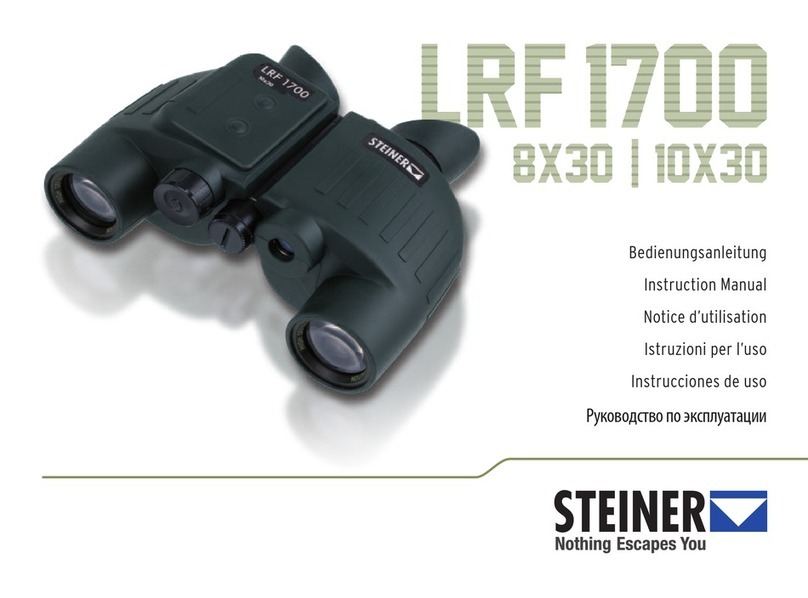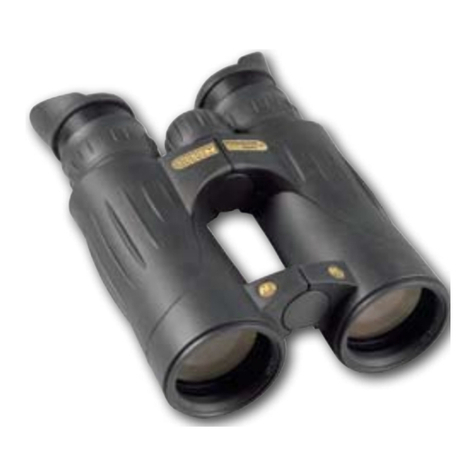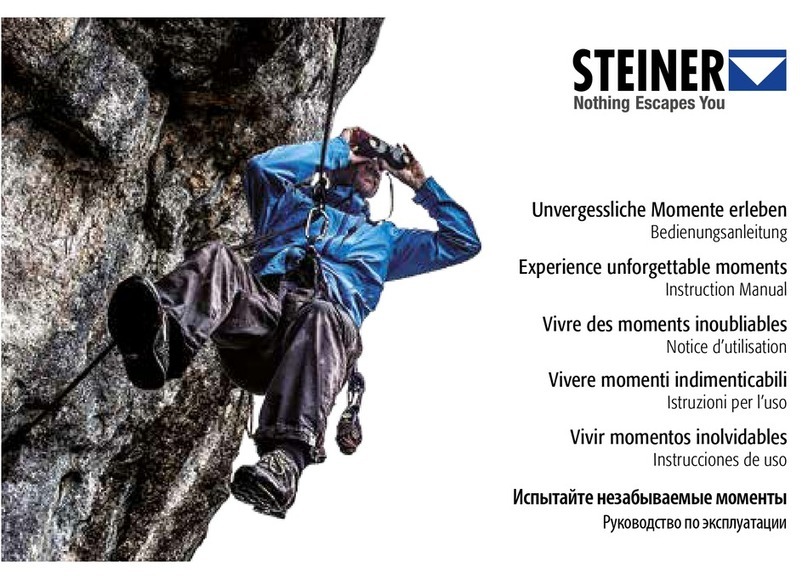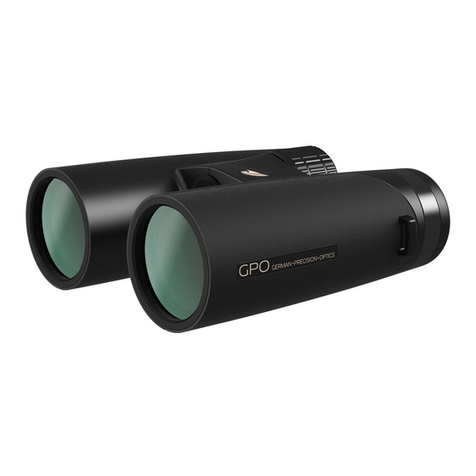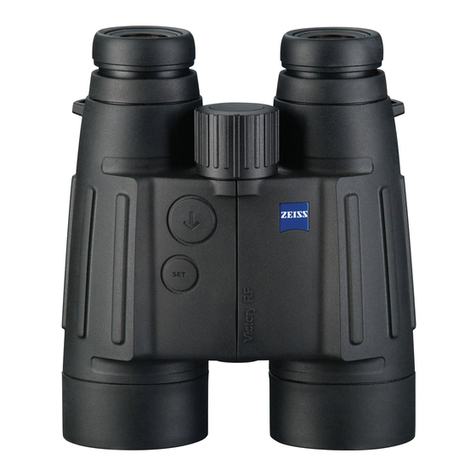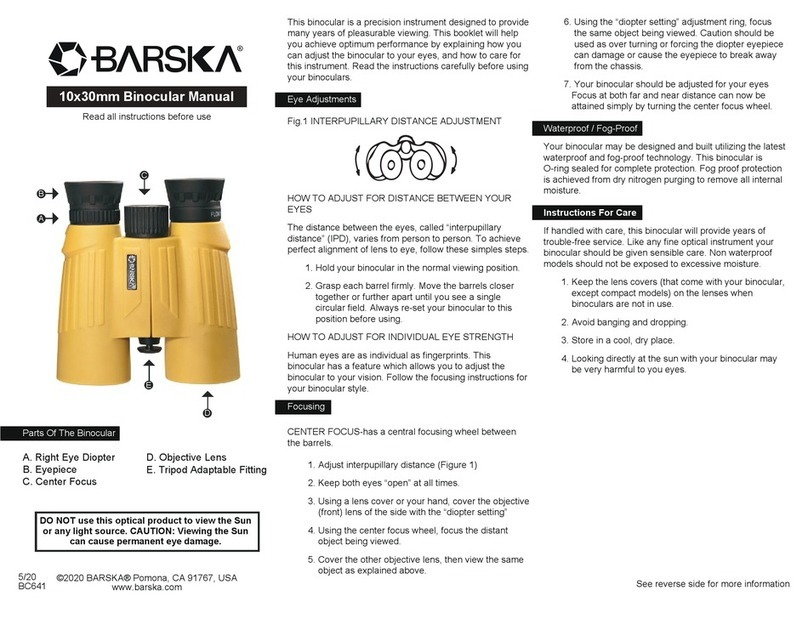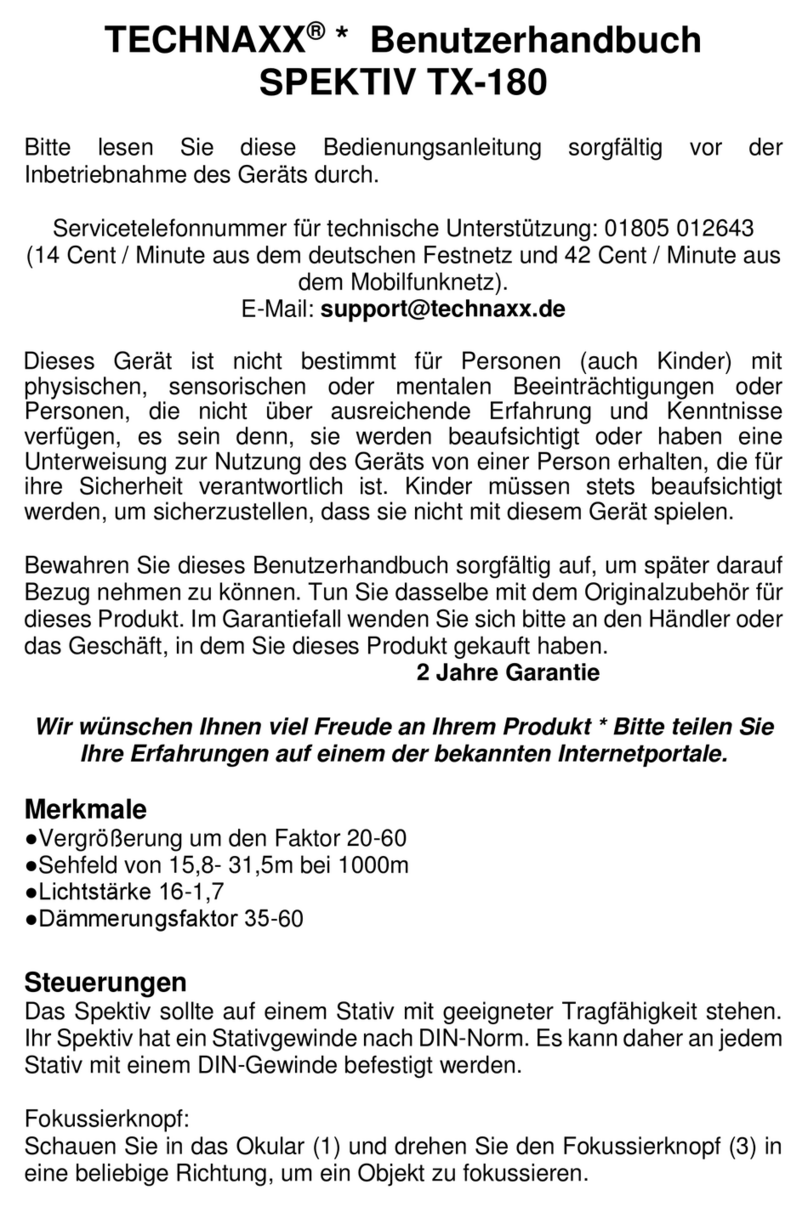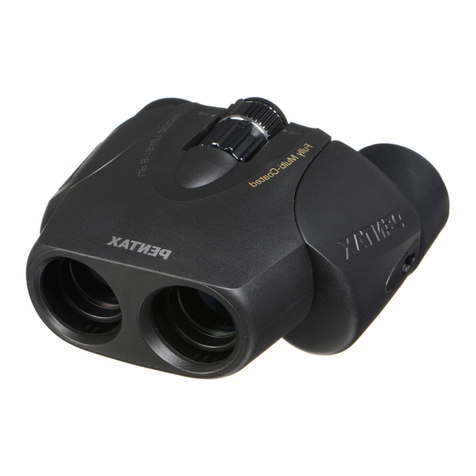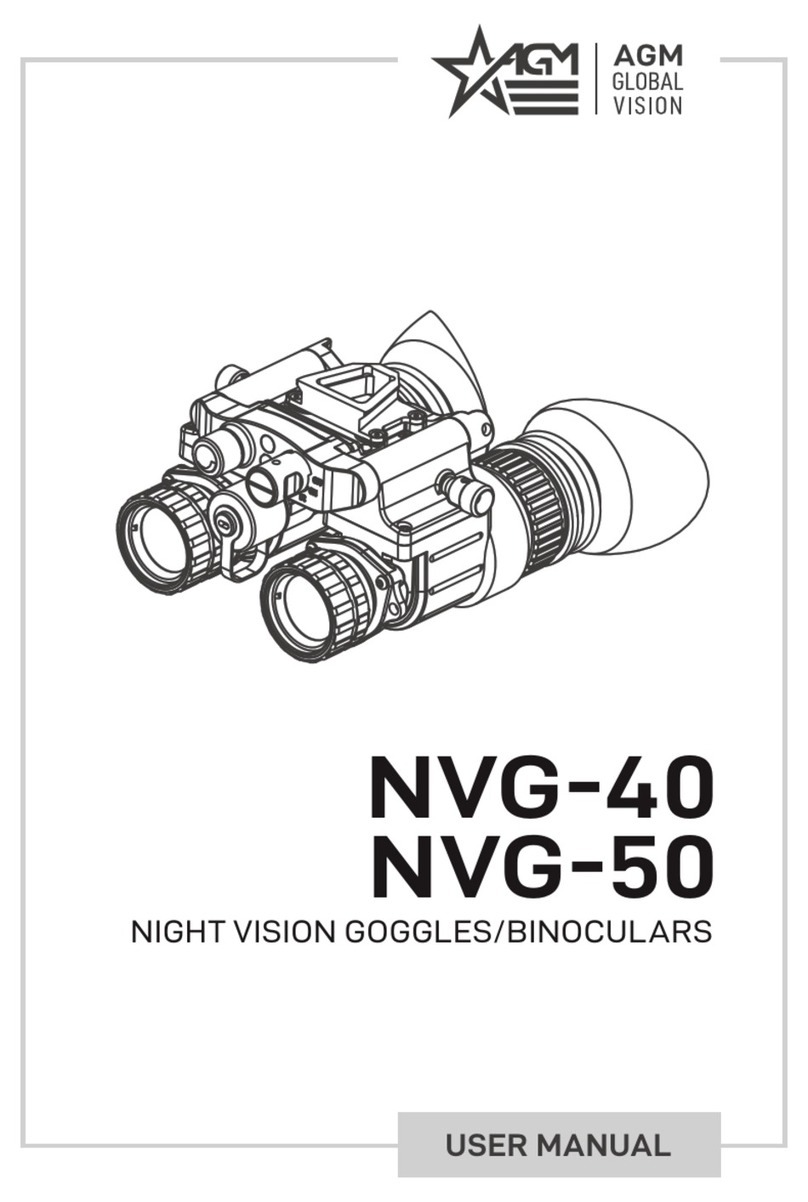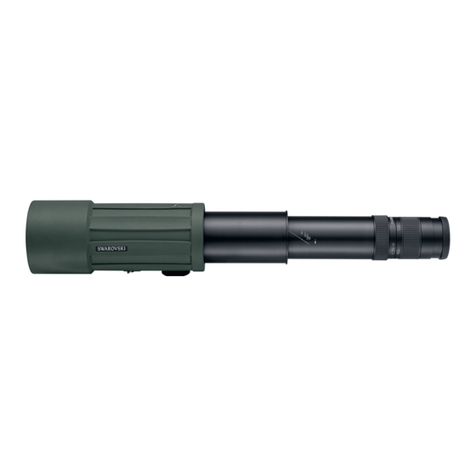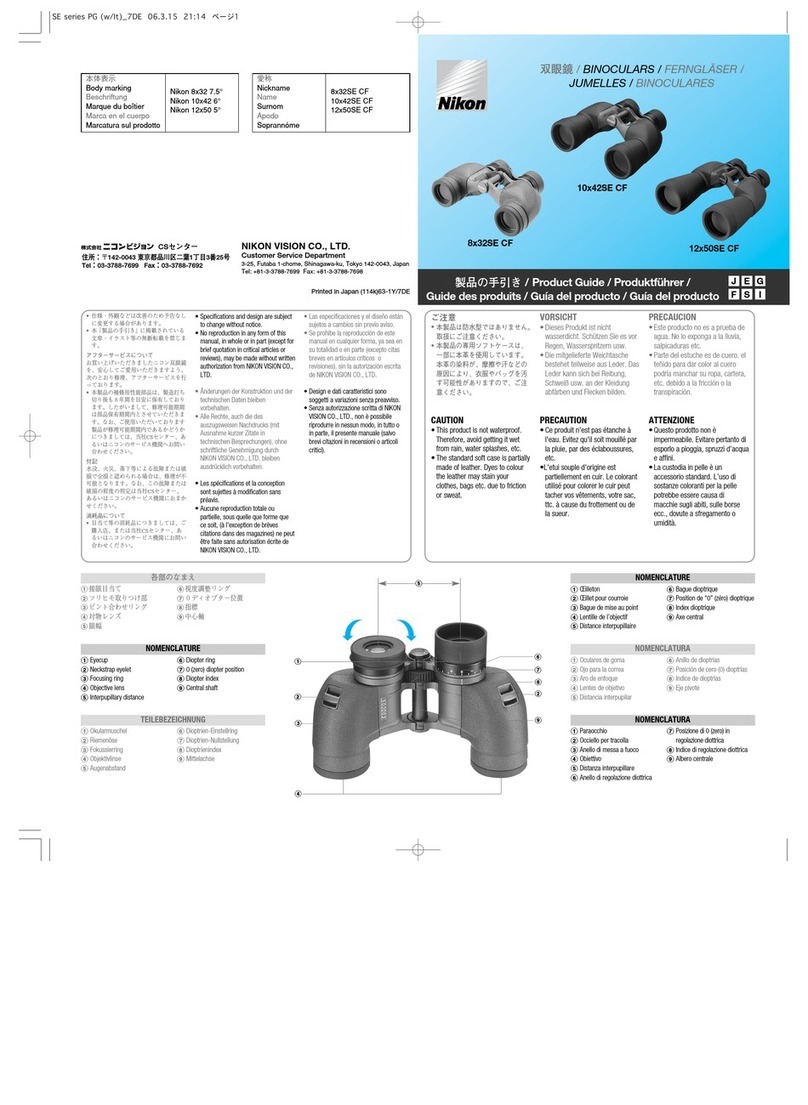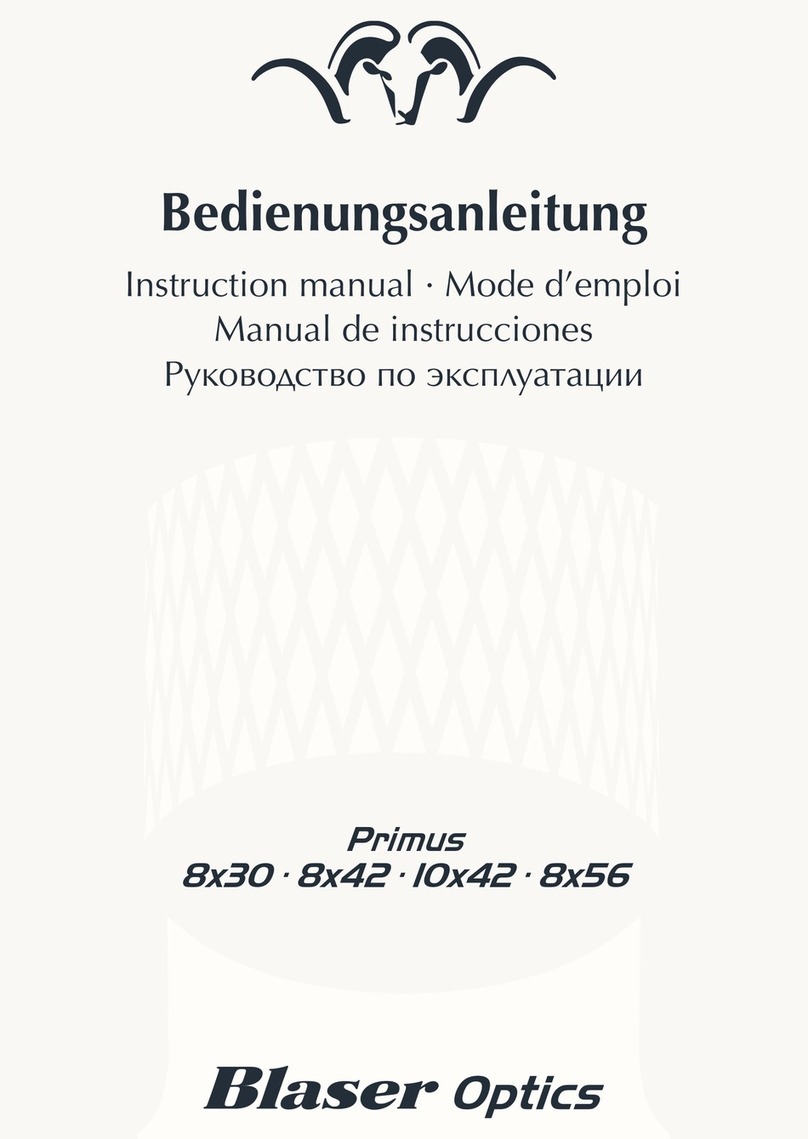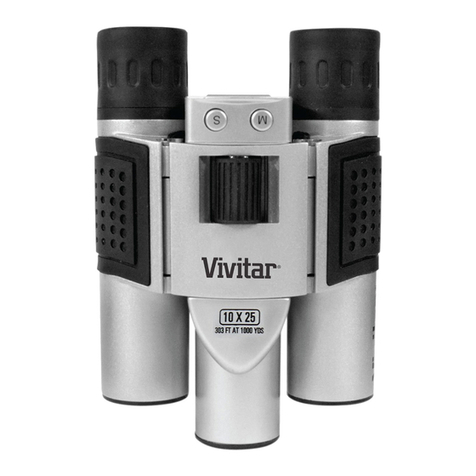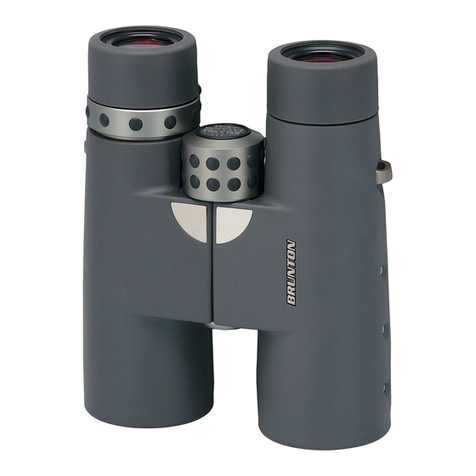Steiner PeregrineXP User manual

USA, Canada & Caribbean
®
A NEW ERA OF INNOVATION
Binocular Instruction Manual
L’INNOVATION ENTRE DANS UNE NOUVELLE ERE
Manuel d’instructions pour les jumelles.
Questo manuale d’istruzione è fornito da trovaprezzi.it. Scopri tutte le offerte per Steiner Navigator 7x50C
o cerca il tuo prodotto tra le migliori offerte di Binocoli e Cannocchiali


3
TABLE OF CONTENTS
Introduction 4-5
Adjusting your binoculars 6-9
Eyecups 9-12
Features 13-14
Carrying strap and Rainguard 14-15
Using the range reticle 16
Using the compass 17
XPTechnology 18-19
Getting the most from your STEINERs 20-21
Warranty 22
®
Peregrine XP
ENGLISH

Congratulations,
You have purchased one of the finest binoculars in the world.
Designed into this product are six decades of experience in manu-
facturing binoculars for the highest demands as well as years of
dedicated research. This manual will provide you with all the
necessary instructions and tips to ensure you the maximum use
and enjoyment of your new STEINERs.

excellence and high optical performance that is required
to build a truly optimal binocular for our customers. You
need to know the user specific requirements as well as
the unique environmental characteristics of where the
binoculars will be used. Binoculars need to
be customized to the situation, whether
there are birds flying or animals hidden in
cover, which are almost invisible to the eye,
or whether glistening sunlight distorts the
colors of nature.
STEINER is passionately committed to the
user’s requirements. We have combined
six decades of experience and research and
development, for professionals and ama-
teurs alike with a deep understanding of
their needs. That’s why fellow hunters, hikers, bird watch-
ers and naturalists can be confident when having a
STEINER binocular in their hands.
We congratulate you for selecting these binoculars, we
thank you for the trust you have placed in STEINER Optik,
and we wish you great times with your STEINER binoculars.
Forests, plains, deserts and mountains all have their se-
crets. Those who are looking to unlock these secrets, for
adventure or to just enjoy nature have a need to know
what is out there. This is what it takes to make your hike,
birding adventure or hunt an unforgettable
experience. The eye is the key: We can act
to only what we see.
STEINER has been producing binoculars for
over 60 years in Bayreuth, Germany.
Founded by Karl Steiner in 1947, STEINER
has become the largest manufacturer of
binoculars in Europe. Today, STEINER is the
only company in the world to specialize
solely in binocular development.
This focus has made STEINER binoculars synonymous
with the highest standard of quality worldwide. STEINER’s
goal is to continue building the toughest and most
weather resistant binocular available. We deliver unsur-
passed brightness and clarity using space age materials
and the latest in optical technology. However, we at
STEINER are convinced that it is more than technical
DEAR NATURE AND OUTDOOR ENTHUSIAST,
5ENGLISH

6
ADJUSTING AND USING
YOUR BINOCULARS
Adjusting the binoculars begins by setting the
interpupilary distance. This is the distance be-
tween the pupils of your eyes. The binocular
tubes pivot on a hinge, moving the tubes
closer or further apart. Pivot the binocular tubes until you
see a single image when looking through the binoculars.
When you don't require glasses in your daily life (or wear
contact lenses), the binocular is now ready for use. All
STEINER binoculars are suited for wearers of glasses. Please
refer to the following pages for detailed instructions.
HOW TO USE THE SPORTS AUTO-FOCUS
All our individual focus models feature Sports Auto-Focus.
The advantage to this feature is that - once set to your
eyes - it allows you to view images from 20 yards to infinity
without having to refocus for different distances. Higher
power models (10x or more) will be in focus from
30-40 yards to infinity. The proper way to
focus the Sports Auto-Focus is:
Choose an image, sign or a tree at least
100 yards away to view.
Cover one of the objective lenses with
your hand or the objective cover.
Look through the binocular with both eyes open.
On the side not covered, turn the ocular’s diopter
setting ring until the image appears clear and sharp.
Uncover the lens and repeat the procedure with the
opposite lens.
When viewing through both lenses, all images from
20 yards to infinity will be bright, clear and in focus.
Higher power models (10x-20x) may require higher
initial focus distance.
Make note of your diopter setting, as it can be unique to
each user. Some models feature the new Memory Ocular,
a device that saves your individual setting. See the
following section for detailed instructions.

7
Never look directly into the
sun with your binoculars or
any optical instrument.
Important!
HOW TO USE THE MEMORY OCULARS
Some models, such as the Commander XP, feature Sports
Auto-Focus along with the Memory Oculars. Use the
previously described steps to focus the binocular for your
eyes. Follow the steps below to set the memory on the
eyepieces:
Press the two tabs on the lower side of the focus ring
while gently pulling up on the eyepiece.
Next turn the memory indicator, which is the small
white arrow shape, to the line on the eyepiece. This is
your individual setting.
Gently push the focus ring back down in place and
release the tabs.
Whenever someone else might change the setting,
you can now quickly check your focus and reset it to
your individual mark if needed.
Memory Ocular
(selected models only)
Rubber Armouring
Eyecups
Diopter Setting
Ocular
Center Axis
Objective Lens
Serial Number
ENGLISH

8
Twist-up/Twist-down
eyecups Sidelight screen
Diopter setting
Center Focusing Wheel
Rubber Armoring
Ocular
Objective Lenses
NPS (Nitrogen-Pressure-System)
Twist-up/Twist-down
eyecups
Choose an image, sign or a tree at least 100 yards away
to view.
Cover the left objective lens with your hand or the
objective cover (if included). Look through the binocu-
lar with both eyes open.
CENTER FOCUS INSTRUCTIONS
Especially for close range glassing at distances below 20 yards
we recommend our binoculars with Fast-Close-Focus. Just a
quick turn of the large center focus wheel and everything is
in focus - up to the most minor detail. The proper way to
initially set a Fast-Focus binocular to your eyes is:

9
The Peregrine
XP features a diopter setting on the left
side ocular. Do not attempt to turn the right side ring.
Turn the center focus wheel to make the image
appear clear and sharp. Uncover left lens.
Now cover the right objective lens with your hand or
the objective cover (if included). Look through the
binocular with both eyes open.
Turn the left ocular’s diopter setting ring until the
image appears clear and sharp.
With both eyes open you
can now use the center fo-
cus wheel to focus the bino-
culars for different distances.
Make note of your diopter
setting, as it can be unique to
each user. Do not force the
diopter wheel or center focus
wheel beyond the noticeable stop limits; this can cause
internal damage.
Preset the binoculars
focus in daylight
conditions. That way
in darkness they’ll
be in focus and offer
the highest depth of
field.
Important !
ERGONOMICALLY
CONTOURED EYECUPS
Standard feature to almost every
STEINER binocular, these eyecups
are especially contoured to elimi-
nate any unwanted sidelight. Your
view will be brighter by eliminating
sidelight. For maximum comfort
these eyecups are made out of soft
silicone material. As an additional
benefit, the soft material allows for the ergonomic part to
be folded down to form a cylindrical shape. Eyeglass
wearers fold the eyecups down all the way to have a full
field of view.
ERGONOMIC TWIST UP / DOWN EYECUPS
Many STEINER models, such as the Peregrine® XP,
Nighthunter® XP or Predator®Xtreme models are
equipped with ergonomic Twist up/down eyecups.
ENGLISH

10
They play an important part in
creating the unique STEINER view-
ing experience. As twist-up / twist-
down eyecups they easily adapt
to your individual preferences,
whether you wear glasses or not.
Eyeglass wearers
Wearing glasses you have already
created the necessary distance be-
tween the binoculars’ oculars and your eyes. Contrary to
users without glasses (or with contact lenses) you usually
don't need to artificially create this distance and you can
use your binoculars with both eyecups fully retracted.
To retract the eyecups simply use your thumb and index
finger to twist them in the direction indicated by the
arrows. Then fold down the sidelight screen. When
looking through your binoculars you can put your glasses
directly onto the eyecups - the soft silicone material
prevents scratching.

11
Different types of eyeglasses might vary the distance
between the eye and the lens and it’s possible that your
eyes are too close to the ocular. You will see some black
areas when looking through the binoculars. In this case
you need to increase the distance by slightly twisting the
eyecup upwards (usually just a few millimeters) until you
see a complete image.
Wearing contact lenses or no eye glasses
You need to create a distance between your eyes and the
binoculars' ocular lenses. Use the binoculars only with eye-
cups in the up position. On both eyecups you will also find
small wings that prevent sidelight to enter and increase
image clarity. To turn the eyecups simply use your thumb
and index finger and twist the eyecups down. To twist
them up, turn them in the other direction until you can
feel the noticeable stop limit - after that you will only be
able to minimally turn the eyecup. This play is necessary to
adjust the sidelight screen for different users' interpupilary
distances.
ENGLISH

CHANGING EYECUPS
Many Steiner models allow for fast owner replacement of
binocular eyecups. The eyecups are either a soft, pliable
rubber or a rubber cup with a solid base. Please visit
www.steinerpartsdirect.com to order extra eyecups for your
binocular, be sure to have the binocular model, size and
approximate age ready when you visit the website or make
contact. Certain models, such as binoculars with twist up/
down eyecups will require the parts do be installed by our
service department, please go to www.steiner-binoculars.
com for return instructions.
Comfort-Balance®Grip
The innovative grip areas of the PeregrineXP series
combine maximum grip with state-of-the-art ergonomic
comfort. Especially during long glassing sessions the Gel-
Pad Grips relieve pressure from your hands and thumbs
and enable an optimal balance of your binocular.
ULTRA-SHARP
FOCUS BINOCULARS
Some STEINER Binocular
models like the 8x30
Wildlife Pro®feature
Ultra-sharp focusing ad-
justment. The adjustment
allows the user to custom
fit the binocular for their
eyes, whether using eyeglasses or not, for optimal image
sharpness.
To adjust these binoculars, first set the center-focus wheel
(1) to the MIDDLE of the adjustment range. Next, follow
the SPORTS AUTO-FOCUS focusing adjustments (found on
page 6) by viewing an object at 100 yards distance and
adjusting each diopter ring (2) to a sharp image for each
eye. Once individually set, you may again use the center
focus wheel for close-in distance or extreme far distances,
or in between whenever increased sharpness is required.
12
1
22

13
reduces the oxygen content within the binoculars to an
absolute minimum.
Lens Caps
The lens caps will protect your bin-
ocular from moisture and prevent
dirt from collecting on the objective
lenses. Using the caps will result in
less frequent cleaning of the lenses.
Rubber Armoring:
All STEINER binoculars come stan-
dard with rhino tough rubber armor.
Not only does this protect the bin-
oculars from shock and damage, but
it is also soft and comfortable in your
hands. Premium models feature STEINER’s innovative NBR
Longlife Armor formula, initially developed for increased
durability under extreme conditions at sea and military
applications. Clean all rubber armor only with damp
cloth.
Serial number:
Every STEINER binocular has a
serial number. This allows us to track
when your binoculars were produced
and allows you a way to identify
your binoculars in case of loss or
theft. Serial numbers are located at the front objective
(large) lens of the binocular on the center axis or on the
underside of the center bridge for some smaller models. The
serial number for the Peregrine XP is behind the right hand
view objective lens towards the top of the binocular.
NPS
(Nitrogen-Pressure-System):
Many STEINER binoculars feature a
Nitrogen-Pressure-System. This inter-
nal dry-nitrogen filling prevents inter-
nal fogging in case of extreme tem-
perature changes. Only STEINER’s two-valve technology
provides a filling process that is gentle to all seals and
ENGLISH

The closed loop on one side will
prevent loss of the part.
To install the Neoprene Rainguard
on the Peregrine XP , slip the cover
over the ocular side of your bin-
oculars. As you attach the carrying
strap make sure that it goes
through the rainguard's loop (3).
This way you can carry the strap
around your neck and keep the
oculars dry. Once you want to use
the binoculars just open one of
the rainguard's buttons and slip
the cover off the binoculars. The
rainguard is still attached to the
carrying strap on the other side and will prevent you from
losing it by accident.
14
NANO Protection Optics®
Protects the optical lenses
especially from environmental
impacts. It is highly water-
repellent (hydrophobic) and
allows for maximum visibility even in the worst weather
conditions. NANO Protection Optics are featured on all
STEINER XP models.
Rain and Dust Protection Cover
To prevent rainwater or dirt to collect on the oculars in
adverse weather conditions most STEINER binoculars are
equipped with a removable rainguard (1). All Peregrine XP
models feature our innovative water-repellent Neoprene
Rainguard (2). Installing the rainguard will also increase
your binoculars’ protection when stored.
The rainguard should be installed before installing the
strap to the binocular. Simply thread the strap through the
attachments on the rainguard and then attach the strap.
with without
1
3
2

15
123
456
789
ClicLoc System (1+2) for fast removal and reattachment: To
install the strap insert the clip - with the little nose pointing
away from the binocular - into the side attachment right next
to the ocular until you feel it positively click. The strap will
hold firmly. To remove the strap push the circular shaped
button or the ribbed release button. While pushing the but-
ton firmly pull the strap insert out of the attachment. The
same technique is used to remove the lens caps on many
models (3). Use the strap slider to fasten the caps when
removed from the lenses (4+5).
Without ClicLoc System (6-7): Place the binocular on a firm,
level surface with the two slits in the rubber armoring facing
you. Now thread one side of the strap through the buckle,
then through the top of the bin-
ocular body and out through the
bottom (8). Now loop the strap
upwards toward the buckle and
thread the loose end through the
back of the buckle (9).
Carrying Strap:
Your binocular is equipped with a carrying strap that might
vary between our different model series. Please refer to your
respective type similar to the images shown here:
Always keep the
rainguard attached
to the strap in order
to prevent losing it
by accident.
Important!
ENGLISH

HOW TO USE THE RANGE RETICLE:
Many STEINER marine binoculars feature a precision reticle
that helps users to determine the distance to objects. If
you know the height or length of what you are glassing it's
easy to determine the range. Two examples demonstrate
how fast and easy it functions
Example: While boating, another boat is crossing your
course. How far away is it? If you estimate the mast height
of that boat to be 50 feet and the vertical scale reads 25,
the distance results from the actual height (50) divided by
the scale height (25) multiplied by 1000: 50/25 = 2 x 1000
= 2000 feet.
Another Example: You're making a landfall on an island at
night. You see the high point of the island in the moonlight,
which reads 1200 feet on your chart. In your reticle the
height reads 20. Range: 1200/20 = 60 x 1000 making it
60,000 feet or approximately 11.4 miles away. Be
certain that the initial point of reference is lined up at sea
level to assure accurate measurement.
16
Formula for use of the Reticle:
Distance: actual height
scale height x 1000
Actual Height: distance x scale height
1000

17
HOW TO USE THE COMPASS:
Not only did STEINER invent the compass binocular, our
Commander XP models are the most advanced marine
binoculars in the world. All 7x50 compass models feature
the largest compass currently available in marine binocu-
lars (Ø 40 mm) as well as illumination. This allows reading
bearings even under extreme conditions. Your compass is
pre-set for the magnetic field in the northern hemisphere
(zone 2).
To read a bearing line up the object to which you would
like to get the bearing on the vertical scale and read from
the compass scale beneath. The bearing is illuminated
by daylight and can be illuminated by a touch of the but-
ton on the side of the compass at night.
Wearing a hat while using the compass binocular might
cover the illumination window of the compass and can
obstruct reading the bearing. Just push the illumination
buton and you will instantly be able to read your current
bearing.
Batteries are used to illuminate the compass. Before you
do anything else, try changing the batteries if the light
does not work. Do the following: Use a coin to open the
battery case by turning it counterclo-
ckwise. Exchange used round cell
batteries with new ones.
Battery types:
7x30 models: 1x 3V CR 1225. 7x50 models: 2x 1,5V 350.
Place the new battery with plus pole towards the top into
the battery compartment. Then close the cover by turning
to the right (clockwise).
Note: The batteries used here have a non-magnetic property.
This way, the compass is not affected and extremely precise
navigation is guaranteed.
Never dispose of your product with other household waste.
Please inform yourself about the local
rules on the separate collection of elec-
trical and electronic products.
1
ENGLISH

18
WHAT REALLY MATTERS:
One of the most important parameters of a high-
performance binocular is its light transmission, which
means the amount of light that ultimately reaches the
human eye.
In low light conditions such as in rain, dusk or dawn a
higher light transmission can make a decisive difference.
However, light transmission does not always equal bright-
ness. Each binocular has many different values for light
transmission, depending upon the wavelength of light
(color). Conventional binoculars tend to deliver limited
peak values only at a certain wavelength (for example:
blue) but lose other colors' transmission (for example: red)
of up to 30%. The result of such transmission peaks, are
color distortions - therefore high peak values will not
improve your binoculars but are actually counterproducti-
ve for a true bright color image.
However behind this relatively simple sounding issue lies a
substantial challenge. Optical lens coatings deliver high
transmission values only for a very specific wavelength. At
the same time, however, it can have adverse effects at
other wavelengths on light transmission, image sharpness
and depth of field. This is why higher quality binoculars
require multiple layers of lens coating that together result
in good performance for the most important colors.

19
REVOLUTIONARY XP TECHNOLOGY:
With our new XP Technology - the result of many years of
research - STEINER solved the puzzle. It allows for the first
time to bring all key optical performance parameters to
maximum levens at the same time, without compromise.
To produce these complex optical coating systems our
engineers have developed a new production processes and
developed a unique high-vacuum, broad band coating
chamber. The end result is a true optical revolution - which
you can now see.
Unique in light transmission and color fidelity:
The XP Technology's unique High Definition (HD) coating
formula allows for light transmission that remains equally
high over the entire visible light range. This assures out-
standing light transmission, high image contrast and truest
color rendition. These are advantages that you will instantly
see with your STEINER XP Binoculars.
Crystal clear image and outstanding depth of field:
At the same time this new optical system delivers a crystal
clear, sharp image. The innovative lens design results in the
highest depth of field ever seen in a roof-prism binocular.
The benefit is less focusing.
Our revolutionary XP Optics are available with selected
models only, such as the Peregrine XP , Commander XP ,
or Nighthunter XP .
ENGLISH

20
Several factors determine the optical performance of a
binocular. They perform to the maximum only when all
these parameters are optimally calibrated and in harmony
with each other.
Magnification
The value indicates how much closer an object appears
through the binocular. The higher the magnification, the
closer the object appears. However, similar to a photo-
graphic zoom lens, a higher magnification narrows the
field of view. With an 8x44 binocular, objects will appear to
be eight times closer than with your naked eyes.
Objective lens diameter
This number affects the objective lens surface area through
which light enters the binocular. The larger the objective
lens, the more light that is able to get into the binocular. Your
image will be brighter in low light conditions. With an
8x44 binocular the objective lens diameter is 44 millimeters.
Field of view
The size of a binocular's field of view is stated in feet or as
an angle and uses the value of reference at 1,000 yards. If
your binoculars offer you a field of view of 390, then you
will be able to see a 390 feet wide image at the distance of
1,000 yards.
Exit pupil
Look through your binoculars and then move it about
12 inches away from your eyes. You will see a bright circle
within the oculars. This dictates how much light that gets
to your eye. The exit pupil is measured in millimeters (mm)
and is a crucial indicator for low-light performance of a bino-
cular. A human pupil can open up to 7 mm in low light and
accordingly, binoculars that are used in low-light condi-
tions should
offer a large
exit pupil.
GETTING THE MOST FROM YOUR STEINERS
Formula for Exit pupil:
Exit pupil = Objective lens Diameter
Magnification
This manual suits for next models
1
Table of contents
Languages:
Other Steiner Binoculars manuals
